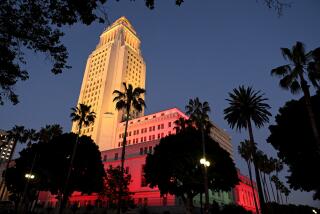Artist Colony, Neighborhood at Odds Over New Local Councils
The famed Brewery artist colony in Lincoln Heights is a creative place indeed.
But, when it comes to determining which neighborhood council the Brewery should join, no amount of creativity has been able to solve a lingering conflict.
The leaders of the fledgling Lincoln Heights Neighborhood Council want to hold on to the Brewery.
“That parcel of land is in Lincoln Heights--period,” said Michael Diaz, a neighborhood council member.
But the leaders of the Brewery see few common interests between its artists and the working-class neighborhood surrounding them. They would prefer to join the other artist colonies to the south in the proposed Downtown Neighborhood Council.
“Lincoln Heights is insisting that they have the power to make us be a part of them, and we don’t want to,” said Don Levy, a Web designer and leader in the Brewery. “The people here want to be in whichever neighborhood council is going to contain the other artists.”
Leaders of the downtown council have mostly let the Brewery and Lincoln Heights representatives try to work out their disagreement--in meetings ranging from shouting matches to more peaceful tones.
Neighborhood councils were authorized two years ago when voters approved City Charter reforms aimed at engaging communities in decision making--from development to provision of public services.
Now, as the process of establishing the much-anticipated system of councils gains momentum, the vague rules handed down by the City Council to govern the setting of boundaries face their first dramatic challenge.
“We are going to see this particular problem repeated throughout the city,” said Greg Nelson, general manager of the city’s Department of Neighborhood Empowerment, established to oversee the process. “That’s why we have the Human Relations Commission all ready to go to provide mediating.”
21 Buildings on 23 Acres
The department began accepting applications to form neighborhood councils this month. The councils must represent at least 20,000 residents in areas that have contiguous boundaries not overlapping those of other councils.
Only four councils have submitted applications so far, but there are 96 others in various stages of development--and eventually many more are expected to form.
The Brewery is a vibrant community of 21 buildings on 23 acres. It houses about 1,500 artists, photographers and musicians two miles up North Main Street across the Los Angeles River from downtown.
With its in-house messenger service, restaurant and other businesses, its residents often refer to the colony as their “oasis.”
The Brewery developed surrounded by a broader community: a combination of industrial, business and modest residential neighborhoods.
The trouble began this summer when residents of the Brewery heard that leaders from the Lincoln Heights council were including the Brewery within their proposed boundaries.
City rules say boundaries “should follow historic and contemporary community and neighborhood borders, use natural boundaries or street lines, and be defined so that all parts of the Neighborhood Council are clearly connected to each other.”
Using these criteria, Lincoln Heights chose the Los Angeles River--six-tenths of a mile west of the Brewery--as its western boundary.
“Before you cross the river it says: Lincoln Heights,” said George Pantazis, a leader in the Lincoln Heights council. “This is not about an ‘oasis,’ but about all of us being together.”
When the Lincoln Heights Neighborhood Council is established, its leaders say, it will lobby the City Council on issues such as facade beautification and an increase in green space--and art.
They see the Brewery as a valuable resource that could be the center of a Lincoln Heights art corridor including the Plaza de la Raza to the north.
“There’s a lot of creativity there,” said Oscar Garcia, a leader in the Lincoln Heights council. “We are looking at using a lot of the talent there to help us in the designing of some of the streetscapes.”
But the Brewery asked the downtown council to include it within its boundaries.
No Hostility, Not Much in Common
Levy said as many as 90% of Brewery residents that he and other leaders have talked to want to join the downtown council. The complex’s artists are primarily interested in affordable rents and promotion of the arts--issues that the other artists in the downtown council are likely to work on.
“While we don’t have any hostility [toward] our neighbors in Lincoln Heights, we don’t have much in common,” Levy said. “They have the interests that would be typical in the community--street maintenance, crime--but the interests that our population has are quite different.”
The Brewery is contemplating joining both councils--or joining neither for a while.
Also, the Brewery and downtown council are considering various ways to keep the Brewery but leave the land around it to Lincoln Heights. One way might be claiming just the railroad tracks up from downtown to reach the Brewery.
Finding a solution is made harder by rules that don’t make it clear whether some of the options being discussed will be allowed, said Nelson.
For example, the rules allow certain “historical” establishments to be part of two or more councils. But there’s no definition of “historical,” so it isn’t clear whether the Brewery qualifies.
The conflict has at least raised the question--among Department of Neighborhood Empowerment staff, City Council members’ aides and the community at large--of whether the council needs to issue clearer rules.
The two sides are trying to come up with resolutions but, in the meantime, the Lincoln Heights and downtown councils have voted to submit their applications claiming the Brewery to the department.
They intend to force the Board of Neighborhood Commissioners--charged with certifying applications--to decide who is right.
But the department is clear on at least this: Applications with conflicting boundaries will probably be turned back to the councils until they resolve their conflicts. As a last resource, the board will send applications to the City Council for its judgment.
“I’m willing to guess that the commission does not want to be in a position of having to [create] winners and losers,” Nelson said.
People from the Brewery and Lincoln Heights agree that this case will set a precedent.
“Do you just allow another neighborhood council to come in [and] . . . take a section of an area?” asked Garcia.
“It behooves us--not just the Brewery--to pay attention,” said Levy, “and be sure that [people] be included within the councils where their needs resonate.”
More to Read
Sign up for Essential California
The most important California stories and recommendations in your inbox every morning.
You may occasionally receive promotional content from the Los Angeles Times.










